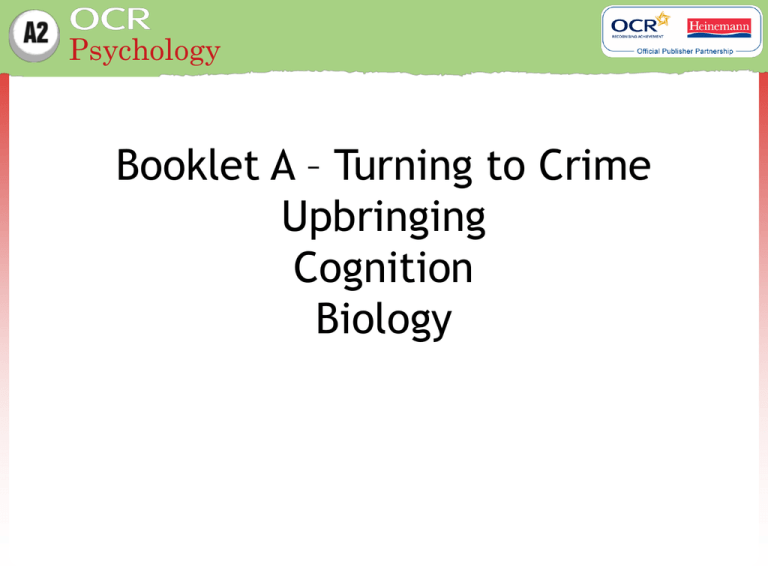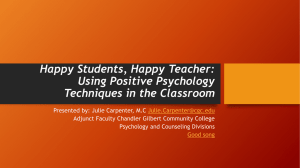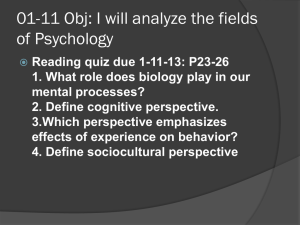
Psychology
Booklet A – Turning to Crime
Upbringing
Cognition
Biology
Psychology
Upbringing
Disrupted families
(Farrington et al. (2006)
Learning from others
(Sutherland (1934)
Poverty and disadvantaged
neighbourhoods
(Wikström & Tafel (2000)
Psychology
Disrupted families
Key Study: Farrington et al. (2006)
Aims
• To document the start, duration and end of
offending behaviour from childhood to adulthood.
• To investigate the influence of life events:
• The risk and protective factors predicting
offending and anti-social behaviour.
• The intergenerational transmission of offending
and anti-social behaviour.
• The influence of family background.
Psychology
Design
• In the latest report on the group, data were
gathered from interviews at age 48 and
searches of criminal records.
Participants
• The study was based on 411 boys, 8- and 9years-old, from the registers of six state schools
in East London who were born in 1953/4.
• The boys were predominantly white working
class.
Psychology
Selected results
• At age 48, of 404 individuals searched in the
criminal records, 161 had convictions.
• The number of offences and offenders peaked
at age 17, closely followed by age 18.
• Those who started criminal careers at age 10–13
were nearly all reconvicted at least once.
• Self-reported crime not covered by official
statistics indicated that 93 per cent admitted
committing one type of offence at some stage
in their lives.
Psychology
Selected results (cont.)
• A small proportion of the study males (7%) were
defined as ‘chronic offenders’.
• Most of these chronic offenders shared common
childhood characteristics; they were more
likely to have a convicted parent, be high
daring, a delinquent sibling, a young mother,
low popularity, a disrupted family and a large
family size.
• The proportion of men leading successful lives
increased from 78 per cent at age 32 to 88 per
cent at age 48.
Psychology
Learning from others
Key study: Sutherland (1934)
• Sutherland’s theory is based on two core
assumptions:
• Deviance occurs when people define a
certain human situation as an appropriate
occasion for violating social norms or criminal
laws.
• Definitions of the situation are acquired
through an individual’s history of past
experience.
Psychology
1. Criminal behaviour is learned.
• Sutherland believed that criminal behaviour
was not inherited or a result of any other
biological condition.
• 2. Criminal behaviour is learned in
interaction with other persons in a process of
communication.
• Sutherland believed such communication
usually involved verbal interaction.
Psychology
3. The principle part of the learning of criminal
behaviour occurs within intimate personal
groups.
• Sutherland felt that intimate personal groups provided
the largest influence on the learning of criminal
behaviour.
• 4. When criminal behaviour is learned, the learning
includes the techniques of committing the crime.
• A criminal has to learn the techniques of the
trade from someone. They also learn the attitudes
taken and excuses made for behaving in a criminal
fashion.
Psychology
5. The specific direction of motives and drives
is learned from definitions of the legal codes
as favourable or unfavourable.
• Groups of people may see certain laws as pointless or
discriminatory and therefore feel they can flaunt them
or that it is right to break them, for example underage drinking laws.
• 6. A person becomes delinquent because of an
excess of definitions favourable to violation of law
over definitions unfavourable to violation of law.
• This is the principle of differential association.
Individuals become criminal due to repeated contacts
with criminal activity and a lack of contact with noncriminal activity.
Psychology
7. Number of contacts with criminals over noncriminals may vary in frequency, duration,
priority, and intensity.
• According to Sutherland, a precise description of the
criminal behaviour of a person would be possible in
quantitative form by analysing the number of contacts
with criminals.
• 8. The process of learning criminal behaviour by
association with criminal and anti-criminal patterns
involves all of the mechanisms that are involved in
any other learning.
• In this point, Sutherland claims that criminal behaviour
is learned just like every other behaviour.
Psychology
9. While criminal behaviour is an expression of
general needs and values, it is not explained
by those general needs and values.
• A thief generally steals in order to obtain
money. However, such an action is no different
from the work of an honest labourer so this
need in itself cannot explain theft.
Psychology
Poverty and disadvantaged neighbourhoods
Key study: Wikström and Tafel (2000)
Design
• A cross-sectional study.
Sample
• Nearly 2000 Year 10 (14– to 15–year-old) pupils.
Methodology
• Interview and data collection.
Psychology
Selected findings
• 44.8 per cent of the males and 30.6 per cent of the
females had committed at least one crime.
• 9.8 per cent of the males and 3.8 per cent of the
females had committed a serious crime of theft.
• One in eight offenders were reported to or caught
by the police for their last committed crime.
• Offenders were more often victimised than nonoffenders.
• Offenders were more often drunk and more often
used drugs than other youths.
Psychology
Explanatory factors
• The study covers a wide range of factors that
may predispose to criminal activity:
• family social position
• individual characteristics
• social situation
• lifestyle and routine activities
• community context.
Psychology
Explanatory factors (cont.)
• Youths with many individual risk factors offend
frequently, while youths with many individual
protective factors rarely offend.
• Of these, the most important were the youths’
individual characteristics and the way they
lived their lives, which strongly affected their
involvement in crime.
Psychology
Conclusions
•
The findings suggest the presence of three groups of
adolescent offenders.
1. Propensity-induced
• These youths have an enduring propensity to
offend.
2. Lifestyle-dependent
• Offending by this group appears to be highly
dependent on their lifestyle.
3. Situationally-limited
• These are individually well-adjusted youths who
may occasionally offend if their lifestyle exposes
them to high levels of situational risk.
Psychology
Upbringing – overall conclusions
• Crime appears to run in families although the
mechanism by which this happens is unclear;
genes, SLT, Differential Associations
• There are risk factors in the family that
predispose individuals to crime including
convicted parent, delinquent sibling, large
family, family social position and community in
which you are raised
• There are also individual factors that
contribute to offending
Psychology
Upbringing – possible section a questions
• Describe research into the influence of the
family in turning to crime.
• Describe how upbringing contributes to criminal
behaviour
• Outline the relationship between poverty &
neighbourhood & turning to crime
Psychology
Upbringing possible section b questions
• Discuss the difficulties of conducting research
into the effect of upbringing on turning to
crime
• Discuss the usefulness of research into the
effect of upbringing on turning to crime
• Compare individual and situational factors in
upbringing explanations of turning to crime
Psychology
Cognition
• Criminal thinking patterns (Yochelson &
Samenow (1976)
• Moral development and crime (Palmer & Hollin
(1981)
• Social cognition (Gudjonsson, G. H. and
Bownes, I. (2002)
Psychology
Criminal thinking patterns
Key study: Yochelson and Samenow (1996)
Aims
• To understand the makeup of the criminal
personality.
• To establish techniques that could be used to
alter the personality disorders that produce
crime.
• To encourage an understanding of legal
responsibility.
• To establish techniques that can be effective in
preventing criminal behaviour.
Psychology
Participants
• The study was based on 255 male participants from
various backgrounds: blacks, whites, those from
the inner city, those from the suburbs, wealthy,
poor, etc. were all evaluated.
• The population of studied offenders was composed
of those confined to the hospital who had been
found not guilty by reason of insanity, as well as a
roughly equal number of convicted criminals who
were not confined to the institution.
Methodology
• A series of interviews was conducted with the
participants over a period of several years.
Psychology
Selected findings
• Criminals …
• are very restless, dissatisfied and irritable.
• consider requests from their teachers and parents
as impositions.
• continually set themselves apart from others.
• want to live a life of excitement, at whatever
expense.
• are habitually angry.
• are lacking empathy.
• feel under no obligation to anyone or anything
except their own interests.
• are poor at responsible decision-making, having
pre-judged situations.
Psychology
Selected findings (cont.)
• Thirty completed the programme of interviews,
but only nine genuinely changed as a result.
• Yochelson and Samenow acknowledge that the
patients lied and gave the answers they thought
would help their situations improve when the
doctors began the study.
• Many of the thinking errors they found would be
part of a modern-day diagnosis of anti-social
personality disorder, which is generally
considered to be exceptionally difficult to
treat.
Psychology
Conclusion
• In all, 52 thinking patterns were distinguishable
in the criminal personality.
• These were considered to be ‘errors’ in
thinking. Although not unique to criminals, they
were displayed more by criminals.
• ‘Though criminals may differ in the types of
crime that they commit, and their modus
operandi, they exhibit identifiable and
classifiable paralleled errors in thinking’
Psychology
Moral development and crime
Key study: Palmer & Hollin
Aim
To see whether the development of moral
reasoning among male delinquents is delayed
compared to non delinquents
Participants
Midlands
97 convicted male offenders age 13-21
77 non offenders, male & female, age 12-24
Psychology
Methodology
• Correlation – moral reasoning & self reported
delinquency
• Quasi as comparing 2 naturally occurring groups
• Moral reasoning
• Socio moral reflection measure short form
• 11 hypothetical dilemmas
• Self reported delinquency
• 46 item checklist of offences
Psychology
Results
• SRMSF
• Male offenders had least mature moral reasoning –
Kohlberg preconventional
• Female non offenders showed more mature moral
reasoning than male non offenders
• The majority of non offenders were using conventional
level reasoning
• CONCLUSIONS
• Delinquents seem to have deficits in their moral
reasoning and interventions aimed at raising levels of
moral reasoning in areas related to delinquent
behaviour could lead to a decrease in offending
behaviour.
Psychology
Social cognition
Key study: Gudjonsson and Bownes (2002)
Aim
• To examine the relationship between type of
offence and the attributions offenders make
about their criminal act.
• Method
• Using the Gudjonsson and Singh 42 item ‘Blame
Attribution Inventory’ (GBAI) to measure the
offender’s type of offence and attribution of
blame.
Psychology
Participants
• 80 criminals who were serving sentences in
Northern Ireland.
• 20 subjects had committed violent offences
including homicide and grievous bodily harm
(GBH). Their mean age was 29.
• 40 sex offenders included rapists and
paedophiles and those committing a sexual
assault. Their mean ages varied from 41 for the
paedophiles down to 28 for the other offenders.
• 20 had committed property offences including
theft and burglary and their mean age was 29.
Psychology
Results
• Those who had committed sexual offences
showed the most remorse about their
behaviour; this was followed by those who have
committed violent acts against the person.
• Those who have committed violent offences
have the highest mental element scores on the
GBAI, followed by the sex offenders.
• With regard to external attribution (blaming
others/situation), highest scores were found for
violent offenders and lowest for sex offenders.
Psychology
Conclusion
• Offenders attribute blame for their crimes
differently according to their type of crime.
Psychology
Cognition Overall Conclusions
• Criminals have differences in their thinking
patters which may explain why they turn to
crime. These include
• Lower level of moral thinking
• Thinking errors
• Differences in remorse and external attribution
depending on the type of criminal
• However, many of these thinking patterns are
shown by non criminals too
Psychology
Cognition – section a possible questions
• Describe thinking patters shown by criminals
• Describe research which demonstrates a link
between morality and crime
• Outline the attributions of blame used by
criminals
Psychology
Cognition – possible section b questions
• Evaluate the validity of research into cognitive
explanations of turning to crime.
• Evaluate the generalisability of research into
cognitive explanations of turning to crime
• Discuss to what extent cognitions provide an
explanation of turning to crime
Psychology
Biology
• Brain dysfunction (Raine, A. ( )
• Genes and serotonin (Brunner et al. (1993)
• Gender (Daly & Wilson (2001)
Psychology
Brain dysfunction
Key study: Raine (1997)
Aim
• Previous research has suggested that brain dysfunction may
predispose individuals to violent behaviour but no-one has tried to
confirm which particular areas may be involved. So the aim is to
directly assess brain functioning in violent individuals
• Hypotheses
• Seriously violent individuals will have;
• Brain dysfunction in the prefrontal cortex, amygdale, hippocampus,
thalamus and corpus callosum (all previously linked with violence)
• No brain dysfunction in other areas of the brain which have been
related to psychiatric disorder but not violence (e.g. cerebellum)
Psychology
Procedure
•
•
•
•
Quasi experiment
41 NGRI 39 Male, 2 female mean age 34.3
Murder / manslaughter
Referred for assessment due to schiz, head
injury, affective disorder, epilepsy, learning or
personality disorder
• Medication free 2 weeks – checked urine test
• Control group, matched age sex and schiz
Psychology
Procedure cont’d
• Injection of radioactive tracer
• CPT
• PET scan
Psychology
Results
• The murderers had
• Reduced brain activity in prefrontal cortex &
corpus callosum
• Increased brain activity in areas not previously
linked with violence e.g. cerebellum
• Abnormal asymmetries i.e. reduced activity on
their left and increased activity on the right in
some of the areas linked to violence e.g.
amygdale, thalamus & hippocampus
Psychology
Conclusion
• There are some differences in the brain
metabolism of murderers pleading NGRI
• The differences are in areas that are typically
associated with aggressive behaviour
Psychology
Genes and serotonin
Key Study: Brunner et al. (1993)
Aim
• To explain the behaviour of a large family in
the Netherlands where the males are affected
by a syndrome of borderline mental retardation
and abnormal violent behaviour.
Psychology
Participants
• The study was based on five affected males
from the family.
Method
• Data were collected from analysis of urine
samples over a 24-hour period.
Psychology
Results
• The tests showed a deficit of the enzyme
monoamine oxidase A (MAOA).
• A mutation was identified in the X chromosome
of the gene responsible for production of
MAOA.
Psychology
Conclusion
• MAOA is involved in serotonin metabolism.
• The defect in the gene leading to impaired
serotonin metabolism is likely to be responsible
for the mental retardation in the family and
this in turn may account for the violent
behaviour.
• Brunner concluded that the MAOA deficiency
accounted for their inability to regulate their
aggression.
Psychology
Gender
Key study: Daly and Wilson (2001)
Aim
• To find out if homicide rates would vary as a
function of local life expectancy in Chicago.
Method
• A correlational study using survey data from
police records, school records and local
demographic records.
Psychology
Procedure
• The study examined local communities in
Chicago which had lower than average male life
expectancies.
Psychology
Results
• Life expectancy proved to be the best predictor of
neighbourhood-specific homicide rates – it was
possible that young men in these neighborhoods
actually discounted the future and expected to live
shorter lives, thereby escalating the likelihood that
they would increase their risk taking for short-term
rewards.
• Another key finding was that the neighbourhoodspecific rate of absenteeism from school was also
negatively correlated with life expectancy – these
young men see little point in investing effort in
school performance.
Psychology
Conclusion
• One possible explanation they suggest is that
parents are unwilling to invest in their child’s
education by enforcing attendance because
they are also operating on a short time horizon.
• Inequity or the unequal distribution of wealth
and resources in society mean the poorest feel
they have little to lose by engaging in reckless
behaviour.
Psychology
Biology overall conclusions
• Variety of explanations that show links between
brain activity, genes and gender and criminal
behaviour
Psychology
Biology – possible section a questions
• Describe physiological explanations for turning
to crime.
• Outline the link between gender and criminal
behaviour.
• Describe methods used to investigate biological
explanations for turning to crime
Psychology
Possible section b questions
• Discuss the extent to which biological
explanations of turning to crime are
reductionist
• Evaluate the usefulness of research into
biological explanations of turning to crime
• Evaluate the methods used by psychologists to
investigate biological explanations of turning to
crime
Psychology
Other possible section b questions
• Discuss the nature nurture debate in relation to
explanations of turning to crime.
• Discuss to what extent explanations of turning
to crime are reductionist
• Evaluate methods used to investigate
explanations of turning to crime
• Discuss the usefulness of explanations of
turning to crime









